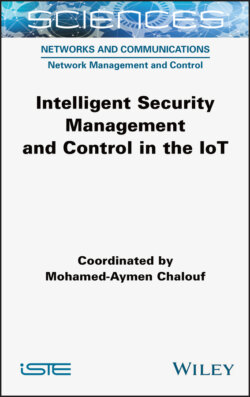Читать книгу Intelligent Security Management and Control in the IoT - Mohamed-Aymen Chalouf - Страница 42
2.2.2.2. Physical layer
ОглавлениеOn the downlink, transmissions are based on OFDM. Each OFDM symbol occupies 12 sub-carriers each of 15 kHz, thus occupying the equivalent of an LTE PRB (180 kHz). Also, in a similar way to LTE, each frame is composed of 10 sub-frames, each of two slots. The durations of the frame, the sub-frame and the slot are 10 ms, 2 ms and 0.5 ms, respectively. Each terminal operates on a Resource Block (RB) formed of seven consecutive OFDM symbols over the whole of the frequency domain. Concerning modulation, only Quadrature Phase-Shift Keying (QPSK) is supported.
On the uplink, transmissions are based on SC-FDMA (Single Carrier-Frequency Division Multiple Access). Two configuration modes are possible: single tone or multi-tone. When single tone is used, the two numerologies 15 kHz and 3.75 kHz are possible. The RU radio resource unit allocated to the terminals corresponds to the deviation from a sub-carrier. We thus have 12 or 48 RU, respectively. In multi-tone, only 15 kHz sub-carrier deviation can be used. The RU can occupy 3, 6 or 12 contiguous sub-carriers. The modulations used on the uplinks are BPSK and QPSK.
The signals and physical channels used in NB-IoT on the uplinks and the downlinks are summarized in Table 2.1 (Savaux et al. 2020).
Table 2.1. Physical channel and signals from the NB-IoT
| Physical channel/signal | Function | |
| Downlink | Narrowband Reference Signal (NRS) | Dedicated to estimating the channel in the frequency domain (provides the reference stage). This signal is transmitted in all the sub-frames except for those reserved for NPSS and NSSS. |
| Narrowband Primary and Secondary Synchronization Signals (NPSS and NSSS) | Inherited from LTE, these signals are used in discovering the cell via a time and frequency synchronization. They also make it possible to discover the identifier of the NCellID cell, notably via the NSSS. | |
| Narrowband Physical Broadcast Channel (NPBCH) | Transports the MIB-NB (Narrowband Master Information Block). This contains 34 data bits (information useful to the terminal, notably when decoding the SIB1-NB, the activation or not of the ACB, etc.) and 16 bits and CRC. The MIB-NB remains unchanged for a period 640 ms. | |
| Narrowband Physical Downlink Control Channel (NPDCCH) | Controls data transmissions between the base station and the NB-IoT terminal. It transports signaling information that governs these transmissions such as resource scheduling on the downlink, data acknowledgments sent on the uplink, the type of modulation used, etc. | |
| Narrowband Physical Downlink Shared Channel (NPDSCH) | Dedicated to the transmission of data in the direction of the terminal. It transports notably the SIB1-NB (Narrowband System Information Block) and some control information. SIB1-NB contains all the information useful for acquiring the other SIB blocks. | |
| Uplink | DeModulation Reference Signal (DMRS) | Dedicated to the estimation of the channel in the frequency domain on the uplink. Unlike the NRS, this signal is always multiplexed with data. It is thus only transmitted in the RUs containing the data. |
| Narrowband Physical Random Access Channel (NPRACH) | Dedicated to transmission of the preamble, which is the first signal transmitted by the terminal, to establish a connection to the network. Details of this channel are given in section 2.2.3. | |
| Narrowband Physical Uplink Shared Channel (NPDSCH) | Used for the transmission both of user data and of control data. The distinction is made using two formats: format 1 and format 2, respectively. |
To permit an extension in coverage while still limiting the maximum transmission power of 23 dBm, NB-IoT devices use improved coverage techniques such as increasing power on the downlinks or the repetition of sub-frames both on the uplinks and on the downlinks. This technique is particularly helpful when the sensors are deployed in zones that are distant or difficult to access. The standard’s target objective is to support a Maximum Coupling Loss (MCL) of at most 164 dB (20 dB more than LTE). The study of the extension of coverage envisaged by NB-IoT in different configurations, carried out in Adhikary et al. (2016), concludes with an MCL support above the 164 dB limit fixed by the 3GPP, that is, MCLs of 170.2 and 172.2 dB for respective spacings of 15 and 3.75 kHz, by carrying out 128 repetitions.
As in LTE, the network can define up to three levels of coverage extension (CE0, CE1 and CE2) to adapt to different radio conditions in which the terminals operate. These levels are defined across two power thresholds based on the power of the reference signal received by the NB-IoT (3GPP 2017a) terminals. Consequently, two thresholds can thus be defined per cell to configure the three levels of coverage. For each level, a number of repetitions of the signal are defined. The greater the power of the signal (less attenuation on the path), the lower the number of repetitions needed.
Unlike the LTE standard that supports the full duplex mode, the choice of half duplex type-B FDD was taken in Rel-13 for NB-IoT (3GPP 2017b). The terminals are therefore either transmitting, or receiving, but cannot carry out both operations simultaneously. In addition, a guard sub-frame is envisaged for each change from the uplink to the downlink or vice versa.
